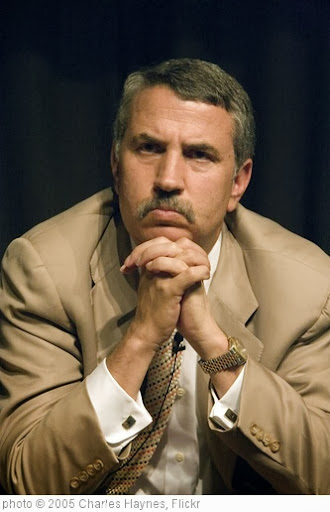New York Times columnist Thomas Friedman is infamous for his uninformed pieces on education though, fortunately, he doesn’t seem to write about the topic as his colleague, David Brooks, who is equally off-base.
In today’s column, The Shanghai Secret, he talks about a visit he made to Shanghai schools with Wendy Kopp of Teach For America. Though I’m not sure I’d make Shanghai my first stop to see educational success (see The Best Sites For Getting Some Perspective On International Test Comparison Demagoguery), he does seem to get something close-to-right:
Shanghai’s secret is simply its ability to execute more of these fundamentals in more of its schools more of the time. Take teacher development. Shen Jun, Qiangwei’s principal, who has overseen its transformation in a decade from a low-performing to a high-performing school — even though 40 percent of her students are children of poorly educated migrant workers — says her teachers spend about 70 percent of each week teaching and 30 percent developing teaching skills and lesson planning. That is far higher than in a typical American school.
Teng Jiao, 26, an English teacher here, said school begins at 8:35 a.m. and runs to 4:30 p.m., during which he typically teaches three 35-minute lessons. I sat in on one third-grade English class. The English lesson was meticulously planned, with no time wasted. The rest of his day, he said, is spent on lesson planning, training online or with his team, having other teachers watch his class and tell him how to improve and observing the classrooms of master teachers.
“You see so many teaching techniques that you can apply to your own classroom,” he remarks. Education experts will tell you that of all the things that go into improving a school, nothing — not class size, not technology, not length of the school day — pays off more than giving teachers the time for peer review and constructive feedback, exposure to the best teaching and time to deepen their knowledge of what they’re teaching.
I’m not sure I’d include class size in that list, but I think he’s certainly hit on that kind of professional development as key.
I’ve got to really wonder, though, how many teachers in Shanghai only teach three three-five minute lessons each day?




Thanks for this Larry.
While Friedman certainly has a respectable pedigree regarding regional politics i.e., the Middle East, unfortunately -he’s become a bit if self-appointed pundit on a range of subjects so broad that he long ago spread himself thinner than credibility permits. His narrow understanding of the topic and place are revealed here again… As a teacher, who lived in China for many years and is married into the culture I can tell you that the Chinese education system leaves much to be desired. Further, as ANY foreigner can tell you, when you visit China your hosts will ensure that you are “handled” in a manner that leads you to see exactly what they believe you want to see and for someone as public with his views as Friedman this is an ultra easy charade to arrange. If one wants a genuinely authoritative voice on Chinese education policy and practice I’d recommend the work of China native Dr. Yong Zhou (http://zhaolearning.com/) who now teaches at the University of Oregon -you’re far more likely to get the real deal from him -not just socially engineered PR. Thanks again for sharing this all with us Larry.